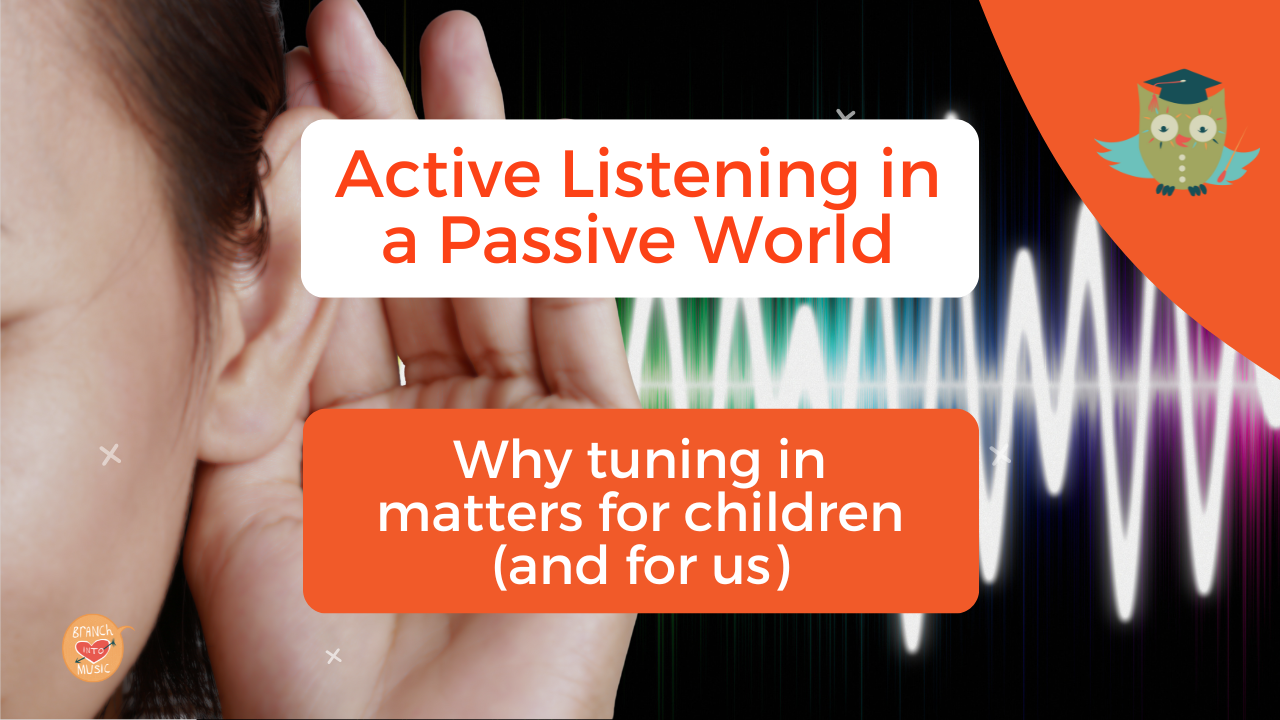Active Listening in a Passive World: Why tuning in matters for children (and for us)
Oct 20, 2025
How often do you really stop and listen – not just hear, but truly tune in – to the sounds around you? The birds outside, the hum of the fridge, the wind in the trees, or the chatter of children at play …
In our noisy, fast-paced world, so much of our listening is passive. Sound is “done to us” – through TVs, traffic, and devices – and we often stop noticing the everyday symphony that surrounds us.
For young children, learning to actively listen – to notice, describe and make sense of sounds – is an essential part of early learning. It builds focus, curiosity, language, and lays the foundations for early literacy.
What is Active Listening?
Active listening means engaging the ears and the mind. It’s about noticing sounds and thinking about what they mean – not just hearing words or music as background noise.
In early childhood, active listening can look beautifully simple:
- Sitting quietly and naming the sounds we can hear inside or outside;
- Imitating the sounds we can make with our own bodies – clapping, tapping, swishing, clicking;
- Listening to the way different instruments sound in a piece of music;
- Talking about how music makes us feel or what it makes us imagine.
These small, joyful moments strengthen children’s auditory discrimination, attention, and vocabulary – the very skills they’ll later use to decode letters and words.
Starting with Everyday Sounds
A lovely way to begin is by inviting children to “turn on their listening ears” – perhaps with a little click and twist action, or by making elephant ears with their hands. These rituals draw attention to the act of listening and make it fun and intentional.
Sit together and listen … What can we hear right now? The wind? A plane? Footsteps?
By noticing and naming the sounds in their environment, children begin to understand that sound has meaning – that listening helps us learn, connect, and enjoy the world more deeply.
From Listening to the World → Listening to Music
Once children are comfortable describing environmental sounds, you can gently guide them towards musical listening. This might begin with simple rhythmic play – tapping, shaking, or singing – then move toward focused listening experiences using short, engaging pieces of music.
Children are naturally curious and creative when they listen to music. Ask open-ended questions:
- What instruments can you hear?
- How does this music make you feel?
- What do you think the music is about?
You can also introduce musical elements – loud and soft (dynamics), fast and slow (tempo), high and low (pitch), thick and thin (texture), and contrasting sections (form).
A Joyful Example: The Kangaroos
One of my favourite listening activities is based on “Kangaroos” from Camille Saint-Saëns’ Carnival of the Animals.
We listen carefully – first noticing the piano hopping and pausing like a kangaroo. Then, with our hands or bodies, we become kangaroos ourselves: jumping, stopping, looking.
This imaginative play transforms listening into movement, story, and connection. Sometimes, a child will suggest a tiger or ghost instead of a kangaroo – and that’s the magic! It shows they’re thinking deeply about the mood and energy of the music.
Listening Across Cultures and Genres
Children benefit from hearing a wide range of musical styles – classical, jazz, folk, and indigenous music and music from around the world.
Many children today grow up with only incidental music from screens or devices, and few experience live music-making. By exposing children to diverse musical experiences, we open their ears (and hearts) to the beauty and creativity of the wider world.
For Babies and Toddlers Too
Even the youngest children benefit from active listening experiences. While babies may not yet have the words to describe what they hear, they are constantly tuning in – to voices, rhythms, and melodies.
When we talk, sing, and listen together, we nurture their language and emotional development. Never underestimate how much they understand.
Why It Matters
Active listening isn’t just about sound — it’s about attention, imagination, connection, and belonging. It helps children make sense of the world and gives them the tools to express their own thoughts and feelings through music and language.
As educators and families, we have the privilege of helping children rediscover the joy of listening – not just hearing – in a world that rarely slows down.
So next time you step outside, pause for a moment …Turn on your listening ears ... What can you hear?
Stay connected with news and updates!
Join our mailing list to receive the latest news and updates from Branch Into Music.
Don't worry, your information will not be shared.
We hate SPAM. We will never sell your information, for any reason.

